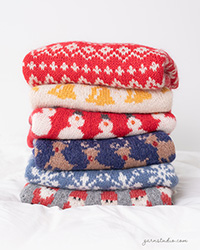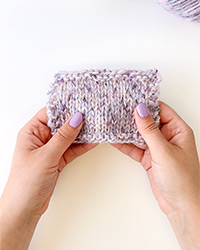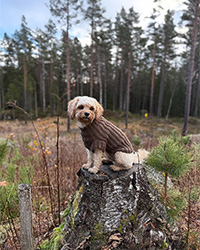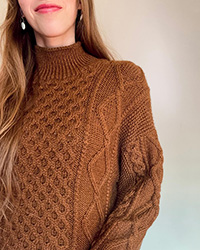Komentáře / Otázky (215)
![]() Véronique Wolff napsala:
Véronique Wolff napsala:
Bonjour Je voudrais une largeur au niveau des aisselles de 43 cm. On est donc entre le XS/S et le M. Puis je tricoter 6 ou 7 mailles au début et à la fin du devant et du dos là où il est noté 8 mailles quelle que soit la taille. Y aura-t-il d\'autres incidences au cours du tricot que de réduire la largeur si je fais ça ? Véronique
12.11.2025 - 08:33
![]() Alexandra napsala:
Alexandra napsala:
Wo finde ich das Diagramm von Drops 131-1?
10.11.2025 - 19:14Odpověď DROPS Design :
Liebe Alexandra, das Diagramm finden Sie rechts neben der Maßskizze. Viel Spaß beim Stricken!
17.11.2025 - 22:30
![]() Carla napsala:
Carla napsala:
Le 8 maglie da diminuire nella manica , vanno diminuite tutte nello stesso ferro?
15.10.2025 - 16:01Odpověď DROPS Design :
Buongiorno Carla, abbiamo leggermente modificato il testo, le maglie del sottomanica vanno intrecciate, tutte sullo stesso ferro come indicato. Buon lavoro!
15.10.2025 - 16:23
![]() Carla napsala:
Carla napsala:
Le 8 maglie da diminuire nella manica , vanno diminuite tutte nello stesso ferro?
15.10.2025 - 16:00Odpověď DROPS Design :
Buongiorno Carla, abbiamo leggermente modificato il testo, le maglie del sottomanica vanno intrecciate, tutte sullo stesso ferro come indicato. Buon lavoro!
15.10.2025 - 16:23
![]() Achsa Griffiths napsala:
Achsa Griffiths napsala:
Is it right that this is knitted in Nepal on needles 7 while it recommends on the wool wrapper needles 5.
10.09.2025 - 19:37Odpověď DROPS Design :
Hi, it is correct, please note that the swatch is also different, not 17 sts x 22 rows but 14 sts x 17 rows. Happy knitting!
12.09.2025 - 10:35
![]() Marja napsala:
Marja napsala:
Hei. hyvännäköinen malli, jonka tekemistä suunnittelen. Mikä koko mahtaa olla kuvan mallin päällä? Oletan mallina olevan naisen olevan noin kokoa 38.
14.03.2025 - 13:20Odpověď DROPS Design :
Hei, emme ole varmoja mallin päällä olevan puseron koosta, mutta neuleen mitat löytyvät ohjeen alaosan mittapiirroksesta.
19.03.2025 - 17:57
![]() Olsson napsala:
Olsson napsala:
Hej! Jag söker efter mönster med 3/4 ärm. Det finns som alternativ. Får dock inget svar. Denna modell kallas 3/4-långa ärmar! Mvh Olsson
25.07.2024 - 16:01
![]() Anne Gara napsala:
Anne Gara napsala:
Bonjour J’ai réalisé ce pull en taille s mais le col est trop large et me tombe sur les bras Êtes vous sur qu’après l’empiècement et le rang de diminution pour ajuster à 96 mailles il faille augmenter 40 mailles au prochain tour endroit pour obtenir 136 mailles ? Merci de votre réponse
21.04.2021 - 18:10Odpověď DROPS Design :
Bonjour Mme Gara, tout à fait, tout est bien correct ainsi. Après ces augmentations, vous tricotez en côtes, ce qui va resserrer l'ouvrage (même si on augmente dans les côtes ensuite). Bon tricot!
22.04.2021 - 07:43
![]() Catherine Martin napsala:
Catherine Martin napsala:
Bonjour, je souhaiterai tricoter le modèle Jackie avec la drops Air, pensez vous qu il y aura un beau rendu ?! Merci pour votre réponse Cordialement. Catherine
18.02.2021 - 19:06Odpověď DROPS Design :
Bonjour Catherine, tricotez un échantillon avec la tension recommandée pour voir si vous aimez la texture obtenue, le résultat sera automatiquement différent car les laines ont des caractéristiques différentes. N'hésitez pas à demander conseil à votre magasin, on saura vous aider. Bon tricot!
19.02.2021 - 07:42
![]() Sandra napsala:
Sandra napsala:
Hei. Jeg lurer på hvorfor det er pinne 7. Jeg trodde Nepal stikkes med pinne 5?
26.02.2020 - 09:17Odpověď DROPS Design :
Hej Sandra, den her model strikkes lidt løsere. Strikkefastheden er på 14 masker = 10 cm. :)
26.02.2020 - 09:55
Jackie#jackiesweater |
|||||||
|
|
|||||||
Pletený DROPS svetřík nebo tunika s copánky, ¾ rukávy a velkorysým límcem z příze „Nepal“. Velikost XS – XXXL.
DROPS 131-1 |
|||||||
|
VZOR: viz schéma M. 1 – schéma zobrazuje jedno opakování, na schéma je nahlíženo z lícové strany. ---------------------------------------------------------------------- TĚLO (svetr i tunika): Pleteme na kruhové jehlici v řadách dokola. POZN.: Údaje před závorkou platí pro svetr, údaje v závorkách platí pro tuniku. V případě, že závorka není, platí údaj jak pro svetr, tak pro tuniku. Na kruhovou jehlici č. 7 nahodíme přízí Nepal 188-212-224-248-260 ok. 1 řadu pleteme obrace, 1 řadu hladce a 1 řadu obrace. Dvě značky umístíme do bočních švů, tj. mezi značkami je 94-106-112-124-130 ok. Pokračujeme následovně: * 8-8-11-11-10 ok hladce, 5-6-6-7-8 ok obrace, 5-6-6-7-7 hladce, 5-6-6-7-8 ok obrace, 6 ok hladce, 5-6-6-7-8 ok obrace, 5-6-6-7-7ok hladce, 5-6-6-7-8 ok obrace, 6 ok hladce, 5-6-6-7-8 ok obrace, 6-6-6-7-7 ok hladce, 5-6-6-7-8 ok obrace, 6 ok hladce, 5-6-6-7-8 obrace, 5-6-6-7-7 hladce, 5-6-6-7-8 obrace, 8-8-11-11-10 hladce * ( = přední díl), upletly jsme všechna oka mezi značkami, mezi *-* zopakujeme ještě jednou (= zadní díl). Ve výšce 5 cm, pleteme nad 6 oky hladce vzorem M. 1 (= 3 krát na předním a 3 krát na zadním díle). SOUČASNĚ ve výšce 13 (16) cm, ujmeme v každém obrace pleteném žebru 1 oko tak, že spleteme 2 oka obrace (= ujmuto 16 ok v řadě). Ve výšce 18 (24 cm), ujmeme jedno oko v každém hladce pleteném žebru tak, že spleteme dvě oka hladce – jedno žebro na každém díle ale vynecháme ( = 4 žebra na předním a 4 žebra na zadním díle) = 8 ok ujmeme v řadě. Ve výšce 23 (32) cm, ujmeme ve všech obrace pletených žebrech jedno oko tak, že spleteme první dvě oka žaebra obrace (= 16 ok ujmuto). Ve výšce 28 (40) cm, ujmeme ve všech hladce pletených žebrech jedno oko tak, že spleteme poslední dvě oka zebra hladce – jedno žebro z každé strany vynecháme (= 8 ok ujmuto). Ve výšce 33 (48) cm, ujmeme ve všech obrace pletených žebrech jedno oko tak, že spleteme poslední dvě oka zebra obrace (= 16 ok ujmuto). Na jehlici je 124-148-160-184-196 ok. Pokračujeme do výšky 39-39-40-41-42 (53-53-54-55-56) cm, v následující kruhové řadě uzavřeme pro průramky 6-6-6-8-8 ok (tj. 3-3-3-4-4 oka z každé strany obou značek) = 112-136-148-168-180 ok. Díl odložíme stranou a pleteme rukávy. RUKÁV: Pleteme na krátké kruhové jehlici v řadách dokola. Na krátkou kruhovou jehlici č. 7 nahodíme přízí Nepal 54-56-58-60-62 ok. 1 řadu pleteme obrace, označíme začátek kruhové řady (= spodní střed rukávu). Pokračujeme následovně: 1-2-3-4-5 ok hladce, * 4 obrace, 3 hladce, 6 obrace, 3 hladce*, mezi *-* opakujeme celkem 3 krát, řadu končíme 4 oky obrace a 1-2-3-4-5 ok hladce Takto pokračujeme, po 1,5 cm vypracujeme 2 knoflíkové dírky: 10-11-12-13-14 ok pleteme vzorem, 2 spleteme obrace, 1x nahodit, 30 ok vzorem, 2 spleteme obrace, 1x nahodit, zbývající oka pleteme vzorem. Dále pleteme do výšky 20 cm. Následně pleteme obráceně, abychom na závěr mohli manžetu otočit: 1-2-3-4-5 obrace, * 4 hladce, 3 obrace, 6 hladce, 3 obrace*, mezi *-* opakujeme celkem 3 krát, řadu končíme 4 oky hladce, 1-2-3-4-5 obrace. Po 6 kruhových řadách pleteme nad 3 žebry pletenými 6 oky hladce vzorem M. 1 (tj. 3 copánky na rukávu). Ve výšce 35 cm – platí pro všechny velikosti, uzavřeme středových 6-6-6-8-8 ok (tj. 3-3-3-4-4 oka kolem značky) – řady přidáme tak, aby vzor navazoval na vzor na těle = 48-50-52-52-54 ok. Oka odložíme a upleteme druhý rukáv. SEDLO: Oka rukávů a těla přesuneme na jednu jehlici = 208-236-252-272-288 ok. DÍL DÁLE MĚŘÍME OD TOHOTO MÍSTA! Značky umístíme mezi jednotlivé díly (= 4 značky). PŘED POKRAČOVÁNÍM SI PROSÍM PŘEČTĚTE CELÝ POSTUP! Nad všemi oky upleteme jednu kruhovou řadu, ve druhé řadě začneme ujímat. UJÍMÁNÍ NA RUKÁVECH: Z každé strany rukávů ujmeme 2 krajní oka tak, že spleteme 2 oka buď hladce, nebo obrace, podle vzoru. Ujímání opakujeme v každé druhé kruhové řadě až k límci. UJÍMÁNÍ NA TĚLE: PRVNÍ ujímání: po 3 cm: v žebrech na předním a na zadním díle pletených 4. oky hladce, ujmeme jedno oko tak, že spleteme první dvě oka zebra hladce ( = ujmuto 8 ok v řadě). Upleteme 5 cm jak se jeví, hladce hladce pletená oka, obrace obrace pletená oka, vzor M. 1 nad vzorem M. 1. DRUHÉ ujímání: v žebrech na předním i zadním díle pletených 8. oky obrace, ujmeme jedno oko tak, že spleteme první dvě oka žebra obrace ( = ujmuto 16 ok v řadě). Pleteme 5 cm. TŘETÍ ujímání: v žebrech na předním i zadním díle pletených 4. oky hladce, ujmeme jedno oko tak, že spleteme poslední dvě oka zebra hladce ( = ujmuto 8 ok v řadě). V TOMTO MÍSTĚ KONČÍ UJÍMÁNÍ PRO VELIKOST XS/S. Ostatní velikosti pleteme 5 cm. ČTVRTÉ ujímání (aplikujeme u 4 největších velikostí): v žebrech na předním i zadním díle pletených 8. oky obrace, ujmeme jedno oko tak, že spleteme poslední dvě oka žebra obrace ( = ujmuto 16 ok v řadě). V TOMTO MÍSTĚ KONČÍ UJÍMÁNÍ PRO OSTATNÍ VELIKOSTI. Vzorem pokračujeme až do výšky sedla 18-19-20-21-22 cm, zde končí také ujímání na rukávech. Na jehlici nyní máme mezi 116 – 168 oky. Změníme velikost jehlic na 5,5 a pleteme 1 kruhovou řadu hladce, SOUČASNĚ ujmeme rovnoměrně na 96-104-112-120-120 ok. Upleteme jednu kruhovou řadu obrace. Následuje kruhová řada hladce a SOUČASNĚ rovnoměrně ujmeme 40 ok = 136-144-152-160-160 ok. Pleteme patentem = 1 hladce/ 1 obrace do výšky 7-8-8-9-9 cm. Dále pleteme patentem 2 hladce/ 2 obrace do výšky 7-8-8-8-8 cm. Následujících 8 cm pleteme patentem: 3 hladce, * 4 obrace, 4 hladce*, mezi *-* opakujeme, řadu končíme 4 obrace, 1 hladce. Změníme velikost jehlic na č. 7 a oka uzavřeme, jak se jeví. DOKONČENÍ: Sešijeme malé průramky. Manžety rukávů přeložíme asi 12 cm do líce, přišijeme knoflíky a zapneme. |
|||||||
Vysvětlivky ke schématu |
|||||||
|
|||||||
 |
|||||||
Dokončili jste tento model?Pak označte své fotky tagem #dropspattern #jackiesweater nebo je pošlete do galerie #dropsfan. Potřebujete s tímto návodem poradit?Otevřete-li si návod na stránce garnstudio.com, najdete tam 10 výukových video-ukázek, Komentáře/Dotazy a další užitečné informace. © 1982-2025 DROPS Design A/S. Vyhrazujeme si veškerá práva. Tento dokument, včetně všech jeho dílčích částí, podléhá autorským právům. Podrobnější komentář k možnostem užití našich návodů najdete dole pod každým návodem na našich stránkách. |
|||||||














































Přidejte komentář k návodu DROPS 131-1
Rádi bychom věděli, co si o tomto modelu myslíte!
Pokud se chcete na něco zeptat, dbejte prosím na to, abyste ve formuláři níže vybrali správnou kategorii - díky tomu se dříve dozvíte, co potřebujete vědět. Povinná pole jsou označena *.